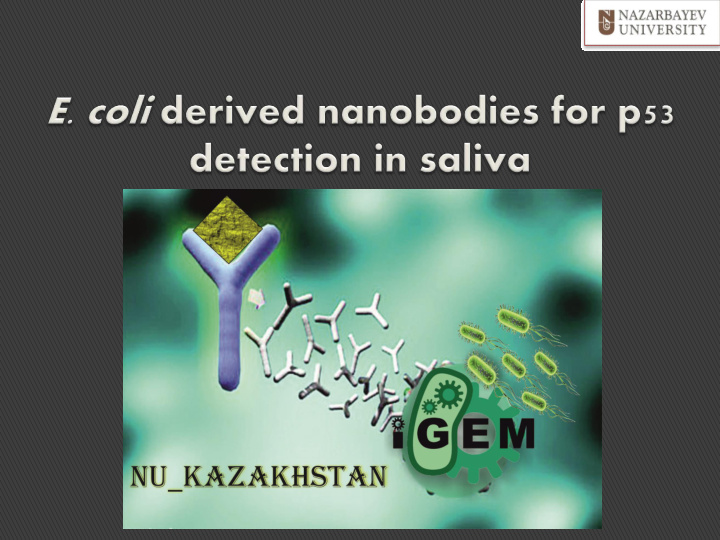



OSCC C – malignant tumor with 640,000 new cases annually worldwide Saliva testing can detect potential biomarkers for OSCC Elevated level of p53 protein was identified in OSCC patients at different stages of disease
~35 monoclonal (mAbs) are approved for therapeutic applications by European Medicines Agency & FDA Most Abs - chimeric/humanized Next-ge generation neration Ab Ab fragments gments: antigen- binding fragments (Fab-s), single chain variable fragments (scFv-s), and heavy-chain Ab-s (HcAb-s)
HcAbs are found in sera of camelids No constant domain CH1, only variable domains: Vh VhH-s or nanobod bodie ies Nanobo bodi dies es (Nb) – smallest naturally occurring fragments (around 120 aa)
Small and soluble Highly stable Bind to target with high specificity Can be conjugated to other proteins without loss of function Can be expressed and secreted in many organisms including E. coli
Vhhp53 Vhhp53 His His RFP RFP HlyA HlyA
Modified E. Coli having functional type I secretion system will be able to secrete VhHp53 nanobody that contains HlyA secretion signal To purify VhHp53 nanobody secreted by E. coli in order to check its affinity for p53 protein E. Coli derived hcAbs for VhHp53 will help to reduce the time spent on diagnostics of OSCC & to lower the costs
Transforming E. coli with hlyB hlyD yD genes in 1. pVDL9.3 DL9.3 (Cm) m) with pUC5 UC57 7 vector encoding Vhhp hhp53 53 ge genes nes Induce expression of the protein with 1uM 2. IPTG (6, 8 and 10 hours) Measure photometric intensity (Varioscan 3. flash 4.00.53) Purify proteins from the media with Ni/NTA 4. columns SDS PAGE 5. Measure concentration (Nanodrop A280) 6. Check the affinity of obtained nanobodies 7. to p53 protein
0.05 0.04 0.03 control: uninduced culture ty, RFU sity, 0.02 6-hour induction Intensi 10-hour induction 0.01 0 1 2 3 4 Samp mple -0.01
1 st elution: 46.95 ng/ul 2 nd elution: 123.16 ng/ul
Obtained pure Vh VhH p53 Participated in Interl rlab ab St Study Next step: to test the affinity of this nanobody for cancer biomarker p53 Futur ure e pla lan: to use this protein-nanobody interaction to design the biosensor for the detection of p53 in saliva samples for OSCC diagnosis
School of Science and Technology, Nazarbayev University Technopark, Nazarbayev University Damira Kanayeva, PhD, Nazarbayev University, Astana, Kazakhstan Luiz Angel, PhD, CSIC, Madrid, Spain Rebecca Bocanegra, CSIC, Madrid, Spain Ana Cuervo, CSIC, Madrid, Spain Kenneth Alibek, MD, PhD, Nazarbayev University, Astana, Kazakhstan Gonzalo Hortelano, PhD, Nazarbayev University Alexander Shustov, PhD, NCB, Astana, Kazakhstan Sholpan Kauanova, Nazarbayev University, Astana, Kazakhstan Nurgul Imangali, Nazarbayev University, Astana, Kazakhstan Madina Shaimerdenova, Nazarbayev University, Astana, Kazakhstan
Abrahao, A. C., Bonelli, B. V., Nunes, F. D., Dias, E. P., & Cabral, M. G. (2011). Immunohistochemical expression of p53, p16 and hTERT in oral squamous cell carcinoma and potentially malignant disorders. Brazilian oral research , 25 (1), 34-41. Ahmad, Z. A., Yeap, S. K., Ali, A. M., Ho, W. Y., Alitheen, N. B. M., & Hamid, M. (2012). scFv antibody: principles and clinical application. Journal of Immunology Research , 2012 . Andersen, J. T., Gonzalez-Pajuelo, M., Foss, S., Landsverk, O. J., Pinto, D., Szyroki, A., ... & Sandlie, I. (2013). Selection of Nanobodies that Target Human Neonatal Fc Receptor. Scientific reports , 3 . Arellano‐Garcia, M. E., Hu, S., Wang, J., Henson, B., Zhou, H., Chia, D., & Wong, D. T. (2008). Multiplexed immunobead ‐based assay for detection of oral cancer protein biomarkers in saliva. Oral diseases , 14 (8), 705-712. Atha, D. H., Manne, U., Grizzle, W. E., Wagner, P. D., Srivastava, S., & Reipa, V. (2010). Standards for immunohistochemical imaging: A protein reference device for biomarker quantitation. Journal of Histochemistry & Cytochemistry , 58 (11), 1005-1014. Chapman, S., Faulkner, C., Kaiserli, E., Garcia-Mata, C., Savenkov, E. I., Roberts, A. G., ... & Christie, J. M. (2008). The photoreversible fluorescent protein iLOV outperforms GFP as a reporter of plant virus infection. Proceedings of the National Academy of Sciences , 105 (50), 20038-20043. De Meyer, T., Muyldermans, S., & Depicker, A. (2014). Nanobody-based products as research and diagnostic tools. Trends in biotechnology , 32 (5), 263-270. Desmyter, A., Spinelli, S., Payan, F., Lauwereys, M., Wyns, L., Muyldermans, S., & Cambillau, C. (2002). Three Camelid VhhH Domains in Complex with Porcine Pancreatic � -Amylase INHIBITION AND VERSATILITY OF BINDING TOPOLOGY. Journal of Biological Chemistry , 277 (26), 23645-23650. Dumoulin, M., Conrath, K., Van Meirhaeghe, A., Meersman, F., Heremans, K., Frenken, L. G., ... & Matagne , A. (2002). Single‐domain antibody fragments with high conformational stability. Protein Science , 11 (3), 500-515. Fraile, S., Muñoz, A., De Lorenzo, V., & Fernández, L. A. (2004). Secretion of proteins with dimerization capacity by the haemolysin type I transport system of Escherichia coli. Molecular microbiology , 53 (4), 1109-1121. Hu, S., Arellano, M., Boontheung, P., Wang, J., Zhou, H., Jiang, J., ... & Wong, D. T. (2008). Salivary proteomics for oral cancer biomarker discovery. Clinical Cancer Research , 14 (19), 6246-6252. Kastelic, D., Frković -Grazio, S., Baty, D., Truan, G., Komel, R., & Pompon, D. (2009). A single-step procedure of recombinant library construction for the selection of efficiently produced llama Vhh binders directed against cancer markers. Journal of immunological methods , 350 (1), 54-62. Kastelic, D., Frković -Grazio, S., Baty, D., Truan, G., Komel, R., & Pompon, D. (2009). A single-step procedure of recombinant library construction for the selection of efficiently produced llama Vhh binders directed against cancer markers. Journal of immunological methods , 350 (1), 54-62. Liu, J., & Duan, Y. (2012). Saliva: A potential media for disease diagnostics and monitoring. Oral oncology , 48 (7), 569-577.
Recommend
More recommend